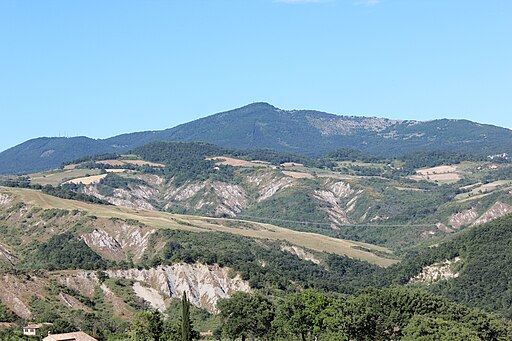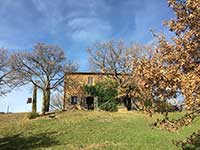Cetona |
The countryside of Cetona is nestled between the populous Val di Chiana and the wilderness of the Val d Orcia in one of the most beautiful areas of west Tuscany. An imposing XV century castle dominates the skyline of the town, standing out against the green backdrop of Monte Cetona. These two dominant profiles the mountain and the castle - are the key to understanding this rich and fascinating area. History and nature overlap and connect here, in one of the few parts of this region that is exuberant and populous and where the visitor can still come across panoramic views of unspoiled countryside. On one side, rolling wooded hills offer superb views towards the distant mountains in Lazio and the Marche, while the other side looks out over the vast and fascinating Val d'Orcia. The views in both directions are stunning, taking in vast natural landscapes. Mount Cetona stands at the south-eastern end of the province of Siena, closing the Val d'Orcia to the east, separating it from the Val di Chiana. The municipalities of Cetona, San Casciano dei Bagni, Radicofani and Sarteano are of interest. On the south-western slopes of Mount Cetona lies the source of the river Orcia, while downstream of the mountain, south of the summit, is the lake of San Casciano.
|
Mappa Cetona | Ingrandire mappa
|
Cetona is a town and comune in the southern part province of Siena, Tuscany, in an area where Umbria and Lazio meet. The geographical elevation is between 250 metres (820 ft) and the 1,148 metres (3,766 ft) of Monte Cetona itself, at the base of which the town is situated at around 350 metres (1,150 ft).
Some of the oldest human settlements of central Italy were discovered at the base of Monte Cetona, such as the early neo-Paleolithic Gosto cave (40–80th century BC) and Lattaia cave (9–10th century BC). The Belverde park hosts 25 prehistoric and Bronze Age caves, such as the San Francesco cave. There are several sites of Etruscan finds. The town of Cetona developed on the hillside around the rocca fortress, containing a square tower (about 900 AD) and an inner fortress wall. It became known as the Scitonia castle. In the first mention of the comune, at the end of the 11th century, Pope Gregory VII granted feudal rights to a member of his family, the Aldobrandeschi. The family's heirs sold the rights,[2] and in the 14th century, Cetona was alternatingly ruled by Siena and Orvieto (until 1354), and, after a brief rule by Perugia, was annexed by Siena. An outer wall was built, containing two round towers (1458). Grand Duke Cosimo I de' Medici of Tuscany sold Cetona in 1556, to the marchese Chiappino Vitelli (1519–75), who made the fortress into a private residence, and built the piazza below it, today named Piazza Garibaldi. His descendants also erected Palazzo Vitelli in the late 17th century. Cetona was connected to Sarteano (1772–1840), and annexed to Italy in 1861. The place name of Cetona or Citonia (local variation) probably comes from the Latin word caedita, "felled, deforested" with regard to a deforested and cultivated place. An early Christian baptistery, now a parish church, mentioned in documents as baptisterium Sancti Johannis de Queneto or de Queteno, may have been named in reference to the Chieteno stream that flows just south of Cetona. Main sights Churches in Cetona are the Chiesa di San Michele Arcangelo (built 1155) and the Chiesa la Collegiata della San Trinita church (1475), as well as the Convento di San Francesco (since 1212) and Convento di Santa Maria a Belverde (frescoes by Cola Petruccioli of Orvieto).
|
||||
Santa Maria in Belverde, Cetona, Val di Chiana [1]
|
||||
|
|
||||
 |
||||
Monte Cetona seen from West, Province of Siena
|
||||
|
||||
| Podere Santa Pia | ||||
Podere Santa Pia is a beautiful stone farmhouse only 2 km away from Castiglioncello Bandini. The main house is spacious, comfortable and well furnished and offers its guests a breathtaking view over the Maremma hills. It is the ideal location for those who wish to enjoy total privacy.
|
||||
|
||||
Podere Santa Pia |
Colline sotto Podere Santa Pia
|
|||
|
||||
| This article incorporates material from the Wikipedia article Cetona, published under the GNU Free Documentation License. | ||||


